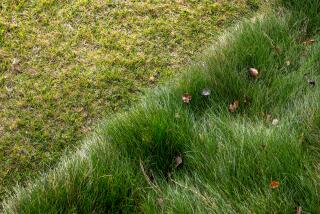Latest Ways to Water Flower and Shrub Beds
- Share via
Watering is a fact of life in Southern California, and while there is no shortage of information on irrigating lawns--with brochures available anyplace that sells sprinklers--how do you irrigate beds of flowers or low shrubs?
The problem is their shape. Typically a garden bed is 2-to-5-feet wide and a good deal longer. The length can vary, but the width is pretty much a given: any wider and water can’t get to plants in back; any narrower just isn’t wide enough to grow much of anything.
There are ways to water these long and narrow beds. Irrigation experts suggest a number of ideas, including several kinds of drip systems, mini-sprays and micro-sprinklers, special “strip” sprinklers and a new generation of small radius pop-ups. Each has its pros and cons.
Circular pop-ups: These are taller versions of the common lawn sprinkler that pop up on either 6- or 12-inch risers. If you put these in front of the flowers and make sure that the plants in front are low, they will pop-up and spray above them.
Low angle, almost flat, sprays are preferred. If there is any breeze blowing when you irrigate, you may need high-angle sprays that throw above those tall plants near the back of the bed. For even coverage, pop-ups should be arranged in a triangular or square pattern so they overlap (as lawn sprinklers should). The spray from one sprinkler head should reach the next head.
In most flower beds with plants of varying height, this would be difficult because the heads in the back would have to be taller than your tallest flowers, so you must settle for simply overlapping those in the front, with less coverage toward the back.
Or, put just the back nozzles on top of very tall plastic risers, a bit of an eyesore.
The radius of circular sprays is usually quite large, but there are new heads that now throw in a radius as little as two feet. The little screw on top of the head controls the radius somewhat, so these are adjustable between 2 and 6 feet.
Or, adjust them by changing the water pressure. Irrigation consultant Bob Galbreath of Garden Technology, Los Angeles, suggests one way of changing the pressure: Use a nifty adjustable pressure regulator made of engineering plastic, manufactured by Bermad. (PRV-075 is the one made for three-quarter-inch pipe valves.)
If you lower the pressure, you shrink the radius, so Galbreath likes to use pressure regulators on each sprinkler line so he can control each system.
These and the smaller radius sprinklers (the smallest is made by Toro) will probably have to be purchased from irrigation supply dealers (look in the classified pages under irrigation or sprinklers). It is doubtful that they will be found at hardware or building supply stores or at nurseries.
Regulating the pressure also stops sprinklers from misting. Reducing the pressure to what the sprinklers were designed to run at, usually around 30 pounds per square inch, makes them much more efficient. (Typical house pressure is 70 psi, pressure at the street can be over 200 psi.)
Strip sprays: Strip sprinklers sound too good to be true. Attached to risers or pop-ups, they water narrow rectangular areas, typically 4 by 20 feet, or even 2 by 6. They must be spaced about 10 feet apart (or three feet apart for the smaller ones) so they overlap.
There are “center strips,” which sit in the middle of the bed, and “side strips,” which go to one side. There are also “end strips,” which are half the pattern of a strip, to cover the ends.
Rain Bird adviser Jim Worcester points out that the pattern is more like a bow tie than a rectangle, but strip sprays cover the area when overlapped, if a little less evenly than regular spray heads on a square or triangular pattern.
Today’s better spray heads (strip and circular) have something called “matched-precipitation rate,” which means no matter what the pattern, the sprinklers inside a given manufacturer’s group put the same amount of water on the ground, so a quarter circle is soaking any piece of ground as thoroughly as a full.
Today’s spray heads are also putting less water per minute on the ground.
Runoff, which is more likely in flowers beds than on lawns, occurs when the ground is sloping or of a dense clay type and can’t soak up the water fast enough.
Today’s sprinklers have a flow of around 1.5 to 2.5 gallons a minute, compared to old brass sprinklers that dumped around four gallons on the ground every minute. If you have heavy clay soils or sloping ground, try to get the “low-flow” or low-gallonage nozzles, which are available for most sprinklers.
You can also get sprinklers with pressure-compensating devices for hillsides.
If all of this sounds hopelessly complicated, you can have Rain Bird design a system specifically for you. Ask for the material (you must draw a diagram showing the dimensions of your garden) at a Rain Bird retailer.
Toro and Rain Bird have planning and installation guides and hot lines. Toro’s is (800) 367-8676; Rainbird’s is (800) 247-3782. You can also call these numbers to request a guide.
Next week: Micro-sprays and mini-sprinklers.






